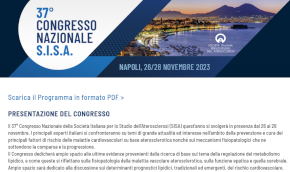 Rivista in lingua italiana
Rivista in lingua italiana
riservata ai Soci SISA
Ultimo numero:
Anno 14 • N.4/2023
Abstract
Unintended effects of statins in men and women in England and Wales: population based cohort study using the QResearch database
Hippisley-Cox J, Coupland C.
BMJ 2010;340:c2197
OBJECTIVE: To quantify the unintended effects of statins according to type, dose, and duration of use.
DESIGN: Prospective open cohort study using routinely collected data.
SETTING: 368 general practices in England and Wales supplying data to the QResearch database.
PARTICIPANTS: 2 004 692 patients aged 30-84 years of whom 225 922 (10.7%) were new users of statins: 159 790 (70.7%) were prescribed simvastatin, 50 328 (22.3%) atorvastatin, 8103 (3.6%) pravastatin, 4497 (1.9%) rosuvastatin, and 3204 (1.4%) fluvastatin.
METHODS: Cox proportional hazards models were used to estimate effects of statin type, dose, and duration of use. The number needed to treat (NNT) or number needed to harm (NNH) was calculated and numbers of additional or fewer cases estimated for 10 000 treated patients.
MAIN OUTCOME MEASURE: First recorded occurrence of cardiovascular disease, moderate or serious myopathic events, moderate or serious liver dysfunction, acute renal failure, venous thromboembolism, Parkinson's disease, dementia, rheumatoid arthritis, cataract, osteoporotic fracture, gastric cancer, oesophageal cancer, colon cancer, lung cancer, melanoma, renal cancer, breast cancer, or prostate cancer.
RESULTS: Individual statins were not significantly associated with risk of Parkinson's disease, rheumatoid arthritis, venous thromboembolism, dementia, osteoporotic fracture, gastric cancer, colon cancer, lung cancer, melanoma, renal cancer, breast cancer, or prostate cancer. Statin use was associated with decreased risks of oesophageal cancer but increased risks of moderate or serious liver dysfunction, acute renal failure, moderate or serious myopathy, and cataract. Adverse effects were similar across statin types for each outcome except liver dysfunction where risks were highest for fluvastatin. A dose-response effect was apparent for acute renal failure and liver dysfunction. All increased risks persisted during treatment and were highest in the first year. After stopping treatment the risk of cataract returned to normal within a year in men and women. Risk of oesophageal cancer returned to normal within a year in women and within 1-3 years in men. Risk of acute renal failure returned to normal within 1-3 years in men and women, and liver dysfunction within 1-3 years in women and from three years in men. Based on the 20% threshold for cardiovascular risk, for women the NNT with any statin to prevent one case of cardiovascular disease over five years was 37 (95% confidence interval 27 to 64) and for oesophageal cancer was 1266 (850 to 3460) and for men the respective values were 33 (24 to 57) and 1082 (711 to 2807). In women the NNH for an additional case of acute renal failure over five years was 434 (284 to 783), of moderate or severe myopathy was 259 (186 to 375), of moderate or severe liver dysfunction was 136 (109 to 175), and of cataract was 33 (28 to 38). Overall, the NNHs and NNTs for men were similar to those for women, except for myopathy where the NNH was 91 (74 to 112).
CONCLUSIONS: Claims of unintended benefits of statins, except for oesophageal cancer, remain unsubstantiated, although potential adverse effects at population level were confirmed and quantified. Further studies are needed to develop utilities to individualise the risks so that patients at highest risk of adverse events can be monitored closely.

Area Soci
Eventi



 SISA LIPID ACADEMY - Corso avanzato di lipidologia clinica
SISA LIPID ACADEMY - Corso avanzato di lipidologia clinicaModena, 22-23 Giugno 2023
[continua a leggere]Giornale Italiano Arteriosclerosi
HoFH today
 Rivista Italiana della
Rivista Italiana della
Ipercolesterolemia
Familiare Omozigote
Anno 5 • N.1/2023
Rivista NMCD
Diateca
[continua a leggere]
[continua a leggere]
Newsletter
il vostro indirizzo di posta elettronica
Progetto LIPIGEN

Nuovo sito dedicato al Progetto LIPIGEN
Progetto LIPIGEN - Vecchio portale
E' necessario essere loggati come utente
Lipigen per poter accedere alla pagina
PROject Statin Intolerance SISA
PROSISA – PROject Statin Intolerance SISA
E' necessario essere loggati come utente
PROSISA per poter accedere alla pagina
GILA - Lipoprotein Aferesi
Gruppo Interdisciplinare Lipoprotein Aferesi
(Accesso Gruppo GILA-Lipoprotein Aferesi)
E' necessario essere loggati come utente del Gruppo GILA per poter accedere
Gruppo Interdisciplinare Lipoprotein Aferesi
(Documentazione ad accesso libero)
Pagina informativa per medici e pazienti








